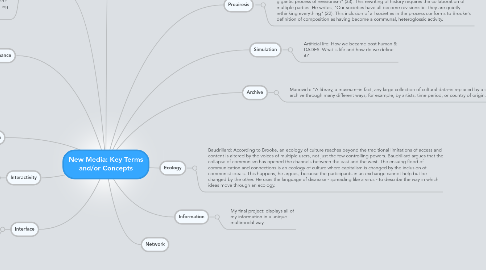New Media: Key Terms and/or Concepts
by Amanda David

1. Persistence
1.1. Convergence Culture: Persistence is the idea of maintaining ideas or concepts across multiple texts. Transmedia storytelling is the perfect example of this. Transmedia storytelling "unfolds across multiple media platforms, with each new text making a distinctive and valuable contribution to the whole. In the ideal form of transmedia storytelling, each medium does what it does best–so that a story might be introduced in a film, expanded through television, novels, and comics; its world might be explored through game play or experienced as an amusement park attraction. Each franchise entry needs to be self-contained so you don’t need to have seen the film to enjoy the game and vice versa” (97). Chapter 3 outlines the Matrix storytelling experience.
2. Performance
3. Pattern
3.1. Hayles: The concept of pattern/randomness overtakes the "presence/absence heirarchy" and comes to the forefront in posthumanism. "Although pattern has traditionally been the priviledged term, randomness has increasingly been seen to play a fruitful role in the evolution of complex systems... chaos accelerates the evolution of biological and artificial life... Randomness [is] not simply...the lack of pattern, but the creative ground from which pattern can emerge." (Hayles 285-286)
4. Interactivity
4.1. McLuhan: "Clients can interact with the masseuse by chatting through their massage or passively receive the massage while sleeping. Similarly, consumers of new media can interact with it or passively receive it. Just as lying in the dark encourages sleeping, certain new media can encourage passivity."
5. Interface
5.1. My final project: changes the interface of how the board views and interacts with my portfolio.
6. Proairesis
6.1. Baudrillard: Proairesis is defined as the process of creation that in our digital world has become an interactive and communal activity. Baudrillard argues that society is engaged in "a gigantic process of revisionism" (33). This rewriting of history requires the collaboration of multiple parties. He writes, "Our societies have all become revisionistic: they are quietly rethinking everything" (22). This inclusion of all societies in the process conforms to Brooke's definition of composition as having become a communal, heteroglossic activity.
7. Simulation
7.1. Artificial life: How we became post human & DADES. What is life and how do we define it?
8. Archive
8.1. Manovich: “A library, a museum–in fact, any large collection of cultural data–is replaced by a computer database. At the same time, a computer database becomes a new metaphor that we use to conceptualize individual and collective cultural memory, a collection of documents or objects, and other phenomena and experiences” (214). Digital storage allows users to access the information in the archive through many different ways; for example, by artists, time period, or country of origin. For example, The National Archives in Washington D.C. features the digital vaults project. The Archives hold more than 10 billion records.
9. Ecology
9.1. Baudrillard: According to Brooke, an ecology of culture reaches beyond the traditional limitations of access and content is altered by the voices of multiple users, not just the few controlling powers. Baudrillard argues that the collapse of communism has opened the channels between the east and the west. The ensuing flood of communication and connections is an ecology of culture where capitalism is changed by the inclusion of communist ideals. This happens, he argues, because the participants in an exchange cannot help but be changed by the other. He uses the language of disaease - spreading like a virus - to describe the way in which ideas move through an ecology.
10. Information
10.1. My final project: displays all of my information in a unique multimodal way.
11. Network
12. Perspective
12.1. Convergence Culture: The writers of fan fiction take the original perspective of the author and tweak it to their liking. For example, Harry Potter fan fiction writers do not have to tell the story from Harry's perspective (as J. K. Rowling does). Instead they may chose to tell it from Ron's, Draco's, or Ginny's perspective. This new perspective changes the meaning of the story, as well as, how the story unfolds.


